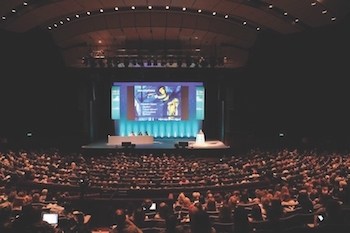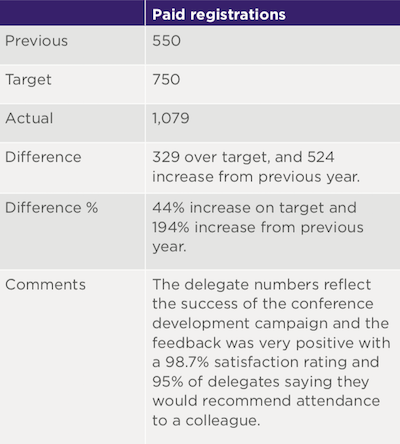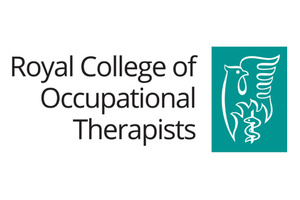Increasing conference attendance by 194%
Success achieved
Increasing conference attendance by 194% and more than doubling the number of self-funded places for the 40th anniversary of a conference.
- Website
- www.rcotannualconference.org.uk
- Project dates
28 – 30 June 2016
Project team
- Martin Reid, Assistant Director of Communications and Marketing
- Vandita Chisholm, Marketing Manager Caz Dunn, Corporate Events Manager
- Sarah Bodell, Chairman of Conference Programme Committee (volunteer)
- Dee Christie, Sue Parkinson, Jennifer Read, Alicia Ridout, Gillian Thistlewood, all members of the Conference Programme Committee (volunteers)
Introduction
The 40th Annual Conference and Exhibition is a landmark event for any organisation and the Royal College of Occupational Therapists wanted to mark this event by ensuring it was the largest conference ever in terms of delegate numbers.
Discovery
The Royal College of Occupational Therapists Annual Conference and Exhibition is the only CPD Annual Conference designed and delivered by the professional body representing occupational therapy in the UK. The conference has a scientific programme based upon peer reviewed abstracts and this is interspersed with invited speakers’ sessions addressing big picture view and insights into matters that the profession faces.
The conference was seen to be quite exclusive, made up with the same delegates attending year on year. To continue attracting this delegate profile would risk the sustainability of the conference.
The other risk facing the conference was a new event that came into the market, which was younger, fresher and seen to be more glamorous by the occupational therapists sector (revealed by the College’s Membership Survey 2015). It attracted a greater number of delegates as it was a free event.
Considering all these factors, it was decided to take a new approach that would open up the opportunities to attend conference to a newer and wider audience. A clear target audience was students and professional members, so our marketing activities and conference design were developed to reach this audience.
Objectives
- Celebrate the 40th Anniversary of the conference by making it the biggest conference in relation to delegate numbers. Target was 750 delegates (up from 550 the year before).
- By securing a significant increase in the number of delegates, we were hoping this would provide a compelling proposition for exhibitors and sponsors for future conferences.
- Define and promote the conference benefits and USP in light of new competition entering the occupational therapy conference market.
- Widen the conference experience to a larger audience, particularly students, to generate awareness of the value of conference attendance and create a desire and demand that will help sustain and future proof the conference.
Activities
The Conference experience was enhanced through creating new partnerships with high profile organisations such as the Guardian newspaper, who were our national media partner, and invited speakers and VIPs, being visible and approachable throughout conference.
Networking was cited by a considerable number of delegates as one of their reasons to attend conference, so formal and informal networking opportunities were created to encourage delegates to meet high profile and notable occupational therapy leaders and influencers. This included an early morning meet and greet session, which was so oversubscribed that it had to run over two mornings, rather than the one morning originally planned.
A radical pricing model that reinforced the 40th Anniversary celebration and made conference more appealing to a wider audience. Students and RCOT members were offered a very special conference rate to celebrate the 40th anniversary.
Social media was engaged to build up the excitement for conference and reach the younger delegates, this was coupled with tried and tested communications used to attract the traditional profile of conference delegates.
Challenges
Managing delegates expectations of attending sessions
With the increased number of delegates, there was some concern that delegates would not be able to get into their session of choice, so all delegates had to pre-register for the sessions they wished to attend. Rooms were allocated accordingly and delegate expectations were managed.
On site delegate registration
To avoid long queues at the registration desks, self-service registration was introduced. This cost was not anticipated, but was deemed to be necessary to ensure the smooth running of the registration system.
Achievements

The targets were met and exceeded. We achieved record delegate numbers. Some conference logistics had to be modified as a result, for example making all sessions bookable.
The presenters who were delivering the scientific programme content were warned that they were likely to have a larger number of delegates attending their sessions and they may have to alter their presentation format.
The formal and informal networking opportunities for delegates to meet their occupational therapy heroes during conference provided another level of excitement and buzz amongst the delegates.
Targets & Statistics

Number of attendees, 2016 vs 2015
The 194% increase of delegates compared to the previous year. This was particularly gratifying as a new conference competitor offering free CPD to the occupational therapy profession had become well established in this marketplace.
38% of delegates were students and nearly 10% of the UK’s occupational therapy student population attended the 40th Annual Conference.
There was an increase in the number of delegates who self-funded (42.5% this year; vs 17% in 2015) and therefore did not rely on their employers to fund their conference places. This reduced the purchasing chain for registration and made it easier for delegates to attend the conference.
50% of delegates cited the special discounted rate as a reason to attend the 40th Annual Conference.
3,623,491 twitter impressions was an all-time world record for an OT conference.
What would we do differently?
Booking of sessions
The delegates will not need to pre-book sessions and seats will be allocated on a first come first served basis on site.
The conference programme
It is intended to make the conference programme more responsive and have the facility to repeat popular sessions.
Printed materials
Provide more on site printed materials for delegates, including venue maps.
Conference logistics
The management of the conference has been reviewed with more services being brought in-house and a conference manager appointed to co-ordinate and project manage the conference logistics.
Feedback & Testimonials
90.5% of delegates who completed the feedback survey stated conference represented excellent/good value for money.
“We learn from examples, and if someone else’s examples can benefit even one patient in our trust, the sharing of information and resources has been worthwhile.“
“Great opportunity to hear about new research in a variety of areas, and great to take advantage of the discounted rate. Couldn’t afford a ticket otherwise.“
“Never been before and as there was a special rate for students I thought it would be a good opportunity to attend and find out how conference was run and meet other occupational therapists”
Wider impact
The increase of delegate numbers took the Royal College by surprise, as we were very aware that there was competition in the occupational therapy sector who were offering CPD for free. It was reassuring to see that delegates valued the conference experience delivered by their professional body.
The increased number of students brought a new energy to the conference experience that speakers and seasoned delegates positively commented on and clearly embraced.
Our initial approach to make the 40th Annual Conference the biggest ever was achieved but in reality, we also broke the mould of the conference, making it a younger, vibrant and more energetic experience where inter-generational networking was encouraged and long standing collaborations that will further the occupational therapy profession were created.


